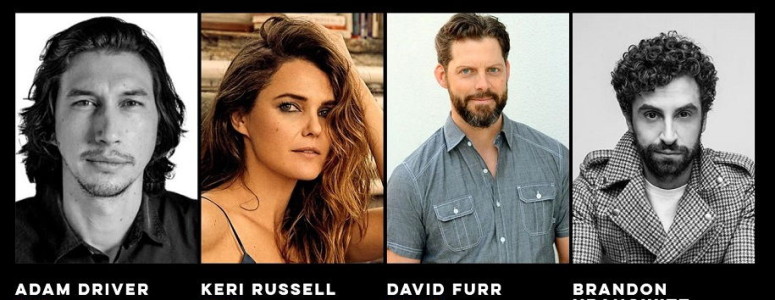Before the show, there’s no real need to read the Playbill to learn that BURN THIS takes place some decades ago.
When the lights come up on Act One, you’ll immediately know you aren’t in 2019 because a young woman is smoking indoors.
Granted, it’s Anna’s own home — a loft that she rents with her gay roommate Larry, which they had been sharing with Robbie.
Alas, the talented dancer and his lover Don were recently killed in a freak accident. Anna’s friend and possible lover Brandon is there to commiserate.
“I thought everything important to the future of dance was going to happen in this room,” Anna tells Larry, gesturing around the loft. It’s not an uninformed opinion; Anna is an experienced dancer too, although her body has lately been telling her that the time has come to choreograph.
Robbie’s death brings his older brother barging – yes, barging — into the loft. He’s Jimmy, but for some untold reason, he prefers to be called Pale.
Perhaps the reason is that other psychopaths pale in comparison to him.
Although Pale has never met either Robbie’s two loft-mates or Brandon, he certainly isn’t worried about making a good first impression. As soon as he enters, he starts a harangue that lasts interminable minutes as he rages with the fury of an uncontrollable forest fire.
It’s all because someone beat him out of a parking space.
Adam Driver has the sound and the fury signifying virtually less than nothing. Watch him roar when his (high-speed) train of thought is interrupted by the standard inner-city banging of heat coming up from a radiator that interrupts. Throughout the play, Driver not merely becomes the guest from hell, but the Guest from All Nine Circles of Hell. This out-of-towner is out of his mind.
Anna didn’t expect to see him because Pale had never bothered to attend a single recital in which Robbie had danced. That was also true of every other family member, for once each had learned he was gay, Robbie was on his own.
Wilson (1937-2011) was capable of writing one-liners that remain as funny — and edgier — than the ones Neil Simon used to routinely dispense. Most come from the gay man, as you might expect.
Brandon Uranowitz easily avoids making Larry just a joke-machine or a joke. He’s first and foremost a self-actualized human being who just happens to be witty. It’s a fine performance.
So which character starts singing a snatch of a song from the FUNNY GIRL film? Don’t be so sure you’re inferring correctly – and don’t be surprised if you don’t buy what Wilson wrote here.
As Act One continues, any failings along those lines are ameliorated by Wilson’s terrific character observations. What Pale doesn’t understand about himself is that his rage comes from the loss of his baby brother that he never really knew or appreciated.
That Anna is at all drawn to This Antisocial Personality Disorder Poster Boy does make a bit of sense, too; he is, after all, a definite link to Robbie, and people do act atypically when they’re grieving.
But after a solid first act, many minutes into Act Two reveal that Anna, Brandon and Larry have a less-than-compelling conversation. They sit around and talk with apparently nothing more to say.
Wilson apparently had nothing more to say, either, so he defaulted to an eternal triangle story. BURN THIS devolves into a soap opera with profanity: Brandon or Pale? With which one should Anna have a relationship?
Brandon (the does-the-job David Furr) is a rich-by-birth screenwriter who doesn’t like the way Hollywood mangles his scripts. (“Beautiful writing is anathema to a movie; there cannot be a good movie”). On the plus side, he’s a slow-and-steady-wins-the-race type of guy. Thus he provides the (expected) marked contrast to Pale. That Larry makes an utterly unbelievable and even unconscionable move to “help” worsens the plot.
Keri Russell delivers the best type of performance an actress can give – which means that she doesn’t seem to be acting at all.
In addition to the aforementioned smoking, many other signposts reveal that BURN THIS takes place more than three decades ago. “Stewardess” has long since been replaced by “flight attendant.” Only veteran and rabid baseball fans will remember Sparky Lyle. Little notes that Pale writes on scraps of paper would now be stored on his iPad. As for Larry’s statement that Robbie’s relatives “believe in the family and children” which would “offend a lot of homosexuals,” he today might well opt for both marriage and kids.
The length also tells us that this is a play of yore. In our current vogue of 90-minute intermissionless shows, Wilson’s play lasts more than two-and-a-half hours. (Luckily, the seats at the recently refurbished Hudson Theatre are plus ad comfortable.)
Yet the ultimate clue that BURN THIS is a play of yore involves the romantic decision that Anna makes. Today, a woman who has a choice between The Bad Boy and The Safe One would probably decide to wait for someone better. Considering what BURN THIS puts before us, we must wonder about the state of her union in another year or maybe less.
Nevertheless, not that many serious plays run a year in their initial runs and then get both a high profile off-Broadway production (in 2002) and a Broadway revival in less than a third-of-a-century. BURN THIS obviously pleases many people; you may well be one of them.




